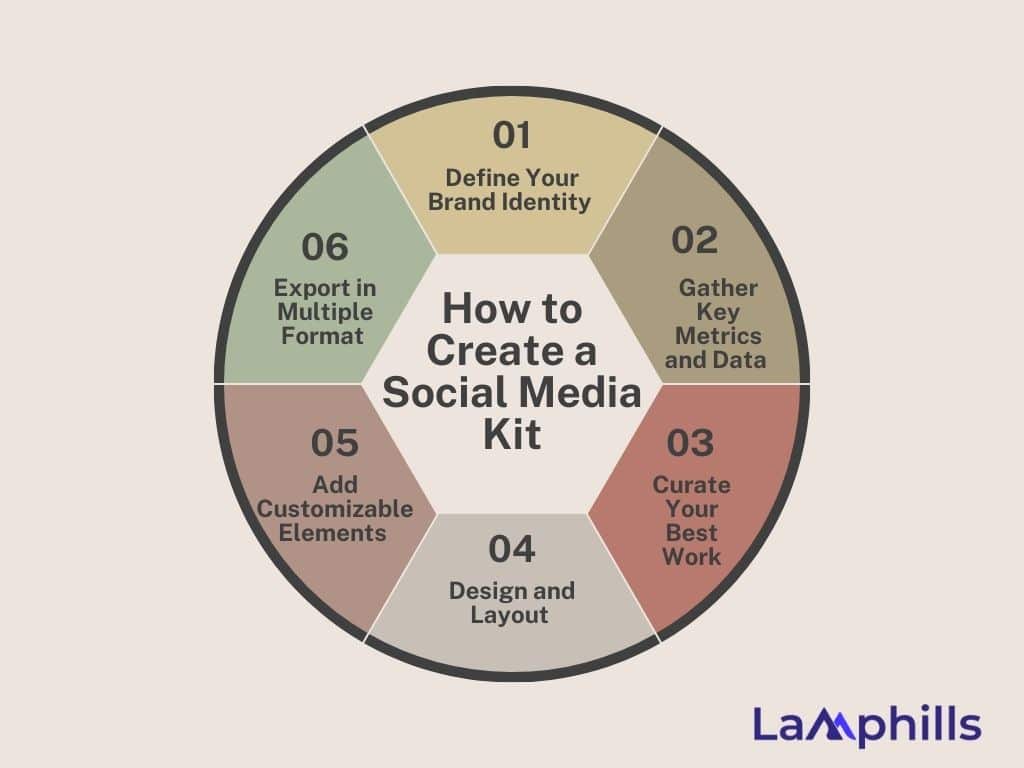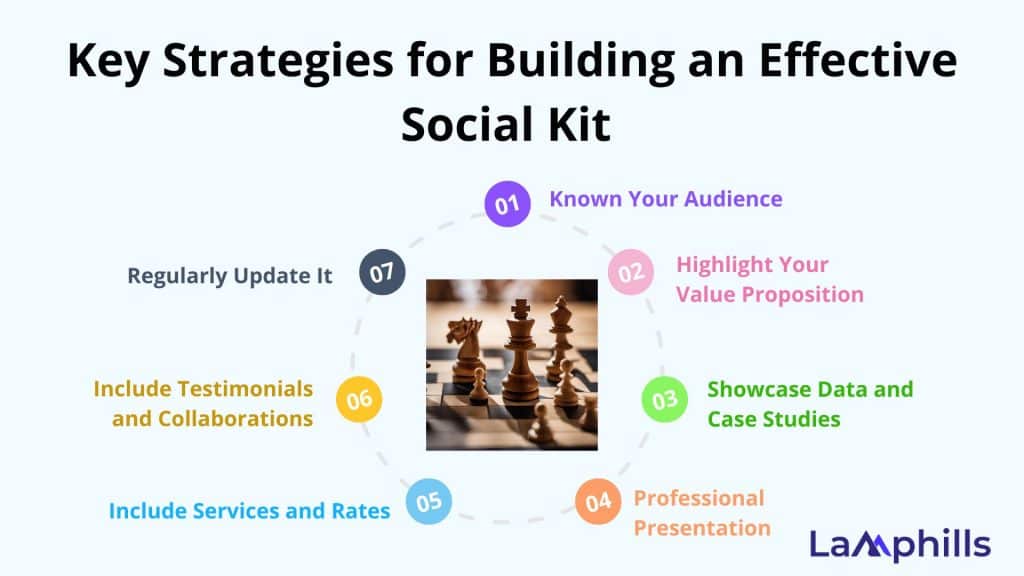A social media kit is a powerful tool for businesses, influencers, and marketers. It’s a professional portfolio showcasing a brand’s unique value and social media metrics to potential partners, clients, or sponsors. A well-organized, visually compelling kit can distinguish between securing high-value collaborations and getting overlooked. Based on my years of working closely with influencers and brands, I present the key strategies for building an effective social media kit with actionable templates to get you started.
Key Points
- A social media kit is a digital portfolio or collection of branded assets and information that showcases an individual, influencer, or business’s online presence across social media platforms.
- It’s designed to present key metrics, content examples, and collaboration options to potential brands, sponsors, or media partners.
- Include testimonials and collaborations in your media kit because social proof is valuable and can convince potential partners of your worth.
- Brands want creators who provide value and measurable impact, not just promises. Therefore, you must prove that you can achieve these goals in record time.
What is a Social Media Kit?
A social media kit is a digital portfolio or collection of branded assets and information that showcases an individual, influencer, or business’s online presence across social media platforms. It’s designed to present key metrics, content examples, and collaboration options to potential brands, sponsors, or media partners. It’s a marketing tool for influencers or brands to pitch their services and value in the digital space. A polished and well-crafted social media kit can set you apart, showcasing your numbers and the value and influence you offer.
Essential Elements of a Social Media Kit
A social media kit serves as your brand’s elevator pitch. It tells potential collaborators who you are and demonstrates your value with measurable data. Here’s a breakdown of the essential components every kit should include, along with expert tips to enhance its effectiveness:
#1. Visual Assets
The first impression your kit makes comes from its visual presentation. High-quality visuals, including your brand’s logo, banner images, and product shots, serve as the visual identity of your business.
#2. Brand Messaging
Your brand’s story and messaging need to be clear and compelling. Include a brief bio, your mission, and your unique selling proposition (USP). A strong message makes it easier for potential partners to understand what makes you or your business unique. First, keep your messaging audience-focused and identify their needs and possible solutions. This is effective when supported by testimonials from satisfied clients or collaborators.
#3. Social Media Metrics
Your social media kit must showcase your success. This can be follower counts, engagement rates, or audience demographics. Potential collaborators are most interested in your ability to drive engagement and convert audiences; numbers provide credibility.
According to Influencer Marketing Hub, over 67% of brands prioritize engagement metrics over follower counts when choosing influencers for partnerships. This is why your engagement rate (likes, shares, and comments) is important. So, use platform-specific tools like Instagram Insights, TikTok Analytics, or Facebook Business Suite to gather the most relevant metrics. For businesses, include metrics related to reach, ROI, and traffic driven from social platforms to your website.
Key Components of a Social Media Kit
The following are the key components of a social media kit:
#1. About You/Your Brand
“In a world where authenticity drives engagement, your story is your brand’s greatest asset.” — Forbes, 2023.
Your social media kit should open with a concise, compelling introduction. This section is where you define who you are, your core values, and the type of content you produce. This isn’t just a bio—it’s your brand story. For example, if you’re an influencer in the wellness space, explain what drove you to focus on health and wellness and how your journey has shaped your social media presence. Keep this section authentic.
#2. Key Social Media Metrics
Brands care about numbers, so highlight your most impressive statistics. However, your focus should be on the following:
- Follower Count: Include up-to-date follower counts across platforms like Instagram, TikTok, YouTube, and LinkedIn. However, remember that quality matters more than quantity.
- Engagement Rate: Engagement shows how actively your audience interacts with your content. A solid engagement rate is typically between 1% and 5%, depending on the platform.
- Audience Demographics: Share data about the age, gender, location, and interests of your audience. A report by HubSpot in 2023 found that 74% of marketers consider demographic data critical when evaluating influencers for brand partnerships.
#3. Content Portfolio
Hootsuite’s 2024 Social Media Trends report states, “The visual appeal and storytelling in influencer content are key drivers of successful brand collaborations.” So, showcase your best work. Brands want to see the kind of content you create and how it resonates with your audience. Generally, your social media kit should include the following:
- Top-performing posts: Select content that generates high engagement and aligns with your niche.
- Media Samples: High-quality visuals, including images, videos, and collaborations, help brands understand your creative style.
#4. Services Offered
Clearly outline the types of services you provide. This makes it easy for potential partners to understand what they can expect from you. Your services can be any of the following:
- Sponsored Instagram posts or stories
- TikTok product demonstrations
- YouTube unboxing videos
- Social media takeovers
#5. Testimonials and Previous Collaborations
Social proof is valuable and can convince potential partners of your true worth. When next you create your social media kit, include the following sections:
- Testimonials from previous clients or brands you’ve worked with.
- Case studies or examples of successful campaigns you’ve been part of. For instance, showing how a partnership led to increased brand visibility or sales adds credibility to your kit and can build potential collaboration.
#6. Rates and Packages
Brands appreciate transparent price lists with no hidden or additional charges. So, provide a breakdown of your pricing for different services. Consider offering tiered packages (e.g., bronze, silver, and gold) that allow flexibility depending on the brand’s budget. A study from Sprout Social (2023) revealed that “68% of marketers prefer influencers who are transparent about pricing upfront, as it saves time in negotiation and ensures budget alignment.”
#7. Contact Information
Include all the relevant ways a brand can contact you. This can be email, phone, or direct message via social media platforms. Secondly, ensure this information is easy to find and well presented.
What Is Included in a Social Media Kit?
Every social media kit should include the following:
- About You
- Audience Insights
- Social Media Statistics
- Content Types & Services
- Campaign Case Studies
- Rates & Packages
- Testimonials
- Contact Information
How to Create a Social Media Press Kit

The following is how I create a social media kit: I’m certain you’ll find it helpful.
#1. Define Your Brand Identity
A social media press kit must reflect your personal or business brand identity. Identify your brand’s voice, tone, as well as values, and integrate these into the kit. Remember to be consistent because consistency in messaging and visuals builds trust. A well-defined brand identity can increase customer loyalty by up to 38%, according to a 2023 study by Lucidpress.
#2. Gather Key Metrics and Data
Your numbers need to be up-to-date and comprehensive. Use tools like Instagram Insights, TikTok Analytics, or YouTube Studio to collect your data. Prioritize high engagement rates and audience relevance over vanity metrics like follower counts. If possible, include recent growth trends to showcase your platform’s trajectory.
#3. Curate Your Best Work
Select content that aligns with your niche and indicate the type of collaborations you want. Ensure you highlight diversity in your content, including images, video snippets, and campaign links. If your work helped brands achieve specific goals (such as a 20% boost in website traffic), mention that.
#4. Design and Layout
A visually appealing kit makes a huge difference. Use tools like Canva, Adobe InDesign, or Google Slides to create a clean, professional design. Stick to your brand’s color scheme, fonts, and logo to ensure consistency. Include visuals that demonstrate your work’s impact (e.g., screenshots of Instagram posts with high engagement). According to a report by DesignRush, “A well-designed media kit isn’t just about aesthetics; it’s about telling your brand’s story through visuals.”
So, always include high-resolution images, logos, and banners that brands can use in promotions. Ensure all your media is properly branded and aligns with your identity.
#5. Add Customizable Elements
Make your social media press kit adaptable. Brands may want to tweak it for specific campaigns or events, so consider leaving certain sections flexible for customization.
#6. Export in Multiple Formats
Once you’ve polished your kit, save it as a PDF for easy sharing. Depending on the context, you might also want to save it in a format that allows easy edits or updates, such as a PowerPoint or Google Slides version.
Key Strategies for Building an Effective Social Media Kit

Brands want creators who provide value and measurable impact, not just promises. Therefore, you must prove that you can achieve these goals in record time. With the right strategies, your social media kit will be your secret weapon for winning high-profile partnerships. Check out the strategies below to ensure your kit stands out, speaks to the right audience, and delivers measurable results for potential collaborations.
#1. Know Your Audience
Your social media kit should be built with a clear understanding of the brands or partners you want to attract. Different companies have different priorities; therefore, craft your messaging to align with their needs. Always include detailed audience insights in your kit. If you have access to your social media analytics, highlight the age, gender, location, and interests of your followers. A recent study by Statista in 2023 reported that businesses are increasingly investing in influencer marketing. So precise audience data is key to proving relevance to brands.
For example, a beauty brand may care more about engagement and niche influence in the beauty community, while a tech brand may focus more on thought leadership and audience demographics.
#2. Highlight Your Value Proposition
According to Hootsuite, content creators with strong niche expertise can command higher rates and long-term partnerships. Clearly defining your value proposition helps you stand out in an increasingly competitive market. During a campaign I managed with a health and wellness company, my expertise in creating engaging health-related content helped me secure the partnership. By showcasing my deep connection with the wellness community, along with a track record of high engagement on posts related to mental health, I could demonstrate why I was the right fit for their campaign.
Your value proposition is the core of your social media kit. It’s where you show potential partners why you’re the best fit for their brand. Think about your unique strengths as a content creator: what sets you apart? It could be your high engagement rates, creative storytelling, a specific niche, or a loyal follower base. This is your chance to market your brand.
#3. Showcase Data and Case Studies
According to Forbes’ marketing analyst, “influencers who can show the tangible impact of their campaigns—such as boosting engagement by 20%—are the ones securing repeat business.”. Data-driven results speak volumes in the marketing world. Brands want tangible proof of your impact, and a social media kit is the perfect place to showcase this. Include case studies of past successful collaborations, outlining the objectives, strategies, and measurable outcomes.
Include key metrics such as:
- Reach and Impressions (how many people saw your content)
- Engagement Rates (likes, comments, shares)
- Conversions (sales or actions taken as a result of the campaign)
Campaign Summary Example:
Collaboration with McDonald’s: The objective was to drive awareness for their healthy breakfast combo, specially made with love. The campaign involved a series of Instagram reels, stories, and static posts, reaching over 500,000 users. The campaign led to a 30% increase in follower growth for the brand.
#4. Professional Presentation
Your social media kit should look as polished and professional as any business proposal. This includes using high-quality images, sleek design, and organized, easy-to-read sections. Think of it as your portfolio—a reflection of your personal brand. I always recommend using Canva or Adobe InDesign to create social media kits, as they offer a range of templates that make content visually appealing. A clean, professional design shows you take your business seriously.
Consider the layout:
- Use a branded color scheme that mirrors your online presence.
- Add visuals, including charts to present data and high-resolution images of past campaigns or collaborations.
#5. Include Services and Rates
Being upfront about what services you offer and at what rates can help avoid unnecessary back-and-forth with brands. So, outline your services clearly, whether sponsored posts, Instagram stories, TikTok videos, or YouTube collaborations. Additionally, include pricing tiers or packages so potential partners can choose what best fits their budget. However, ensure these rates reflect the value you provide.
You can research your market niche to get an idea of average rates; however, consider your unique metrics—such as engagement rate and follower loyalty. Studies show that creators with higher engagement can often charge more, even with a smaller following.
#6. Testimonials and Collaborations
According to AdWeek, testimonials and social proof are deciding factors in brand partnership decisions, helping you build instant credibility. Testimonials from past clients can lend significant credibility to your kit. It reassures potential partners that you’ve worked successfully with other brands and delivered the promised results. Additionally, showcasing logos or names of brands you’ve worked with provides instant recognition and trust.
#7. Regularly Update It
Your social media kit is a dynamic document that should evolve with your career. Every time you run a new campaign or partnership, update your kit to reflect new accomplishments, recent metrics, and collaborations. Early in my career, I failed to update my kit regularly and missed out on opportunities. Once I started keeping it up to date with current campaigns, I began securing higher-quality partnerships. Always ensure your social media kit represents your most recent and best work.
Lamphills SM Kit Templates
These templates will help you create a professional and effective social media kit. Simply tailor them to fit your specific needs and the nature of your brand or business.
Download Lamphills SM Kit Templates
Designing Your Social Media Kit: Best Practices
Your social media kit presentation format can make or break your effort. Even the most valuable content can lose its impact when poorly organized or visually unappealing. Therefore, ensure your social media kit stands out with the following best practices:
#1. Keep it Simple and Professional
Your kit needs to strike a balance between creativity and clarity. A cluttered design can distract from the core message. Keep things sleek, easy to navigate, and visually aligned with your brand. According to Adobe, companies with consistent design identity are 3–4 times more likely to be recognized by customers. This applies to your social media kit as well. Use templates to maintain uniformity while ensuring each section is concise and easy to read.
#2. Choose the Right Tools
Tools like Canva, Adobe Spark, and PowerPoint can help you design a professional social media kit without needing a graphic designer. These platforms offer customizable templates, which allow you to create polished, on-brand assets. Once you’re done, export your social media kit as a high-quality PDF. It keeps the formatting intact and looks professional. It also makes it easy for potential partners to download and share internally.
Related Articles
- How to Create and Share User-Generated Content on Social Media (+ Examples)
- A Comprehensive Guide to the Best Social Media Aggregators in 2024
- A Guide to Paid Media Management: Best Strategies
- A Comprehensive Guide to Digital Media Buying in 2024
- How to Create an Effective Media Plan: Examples and Template






